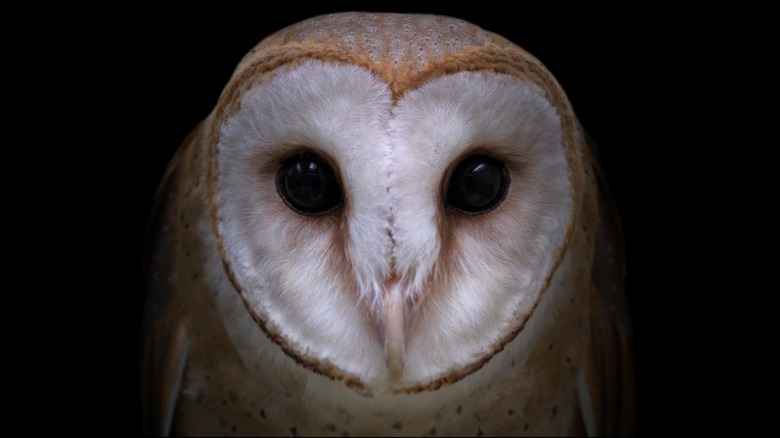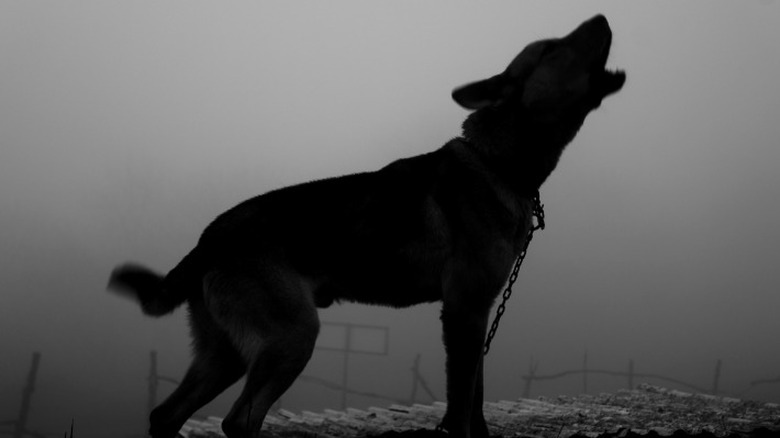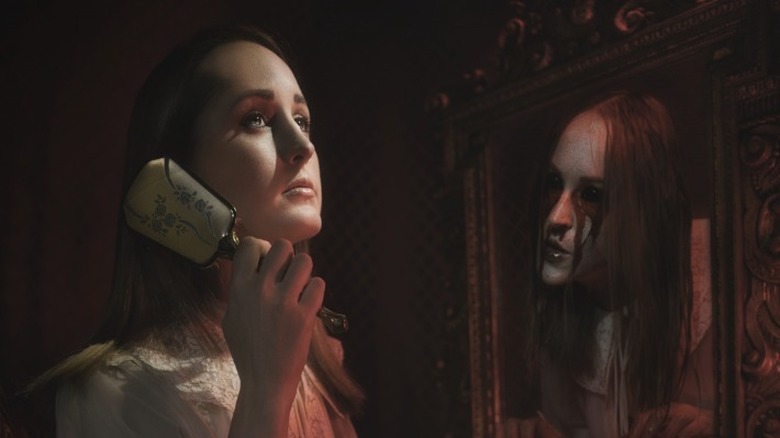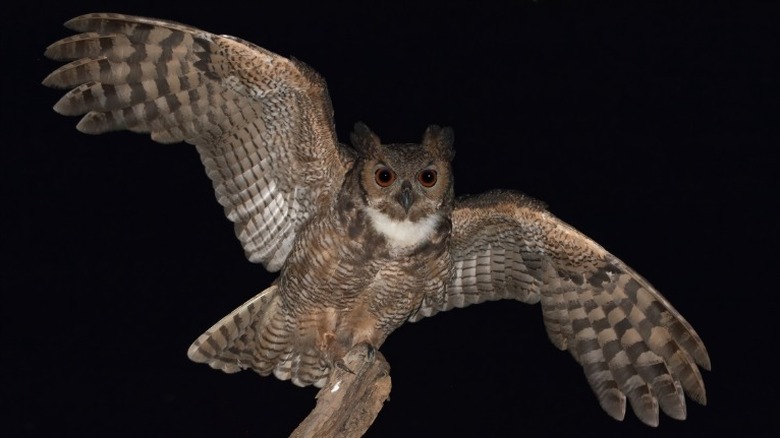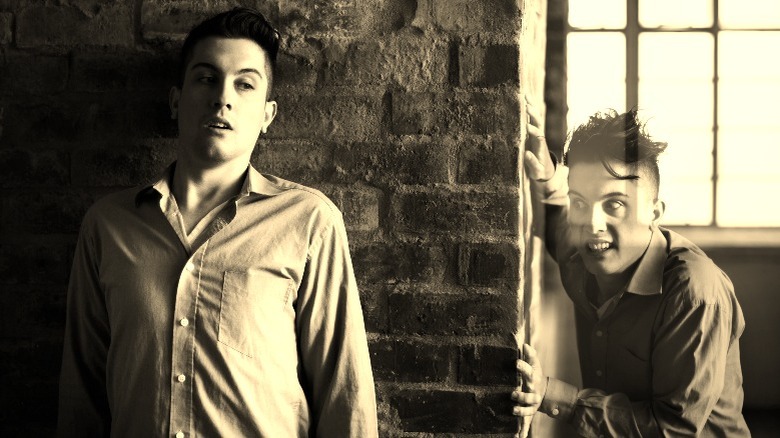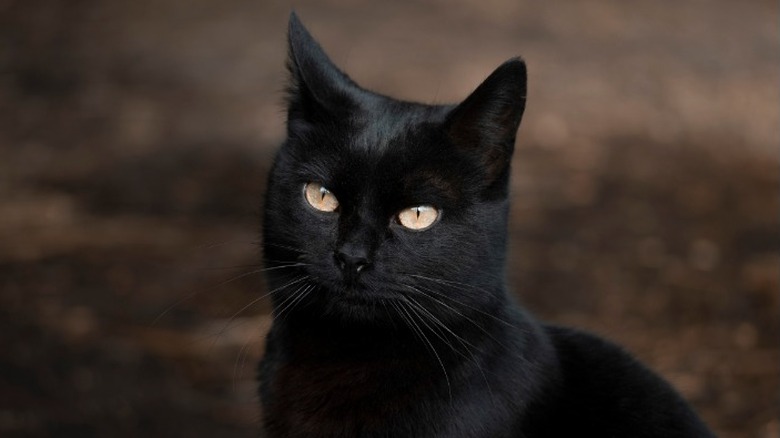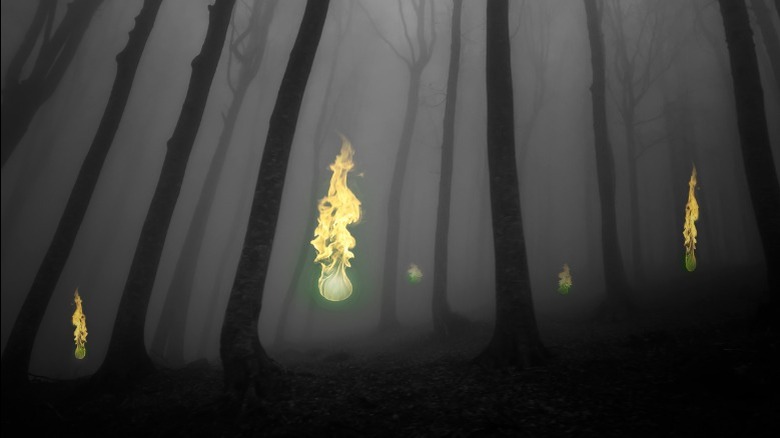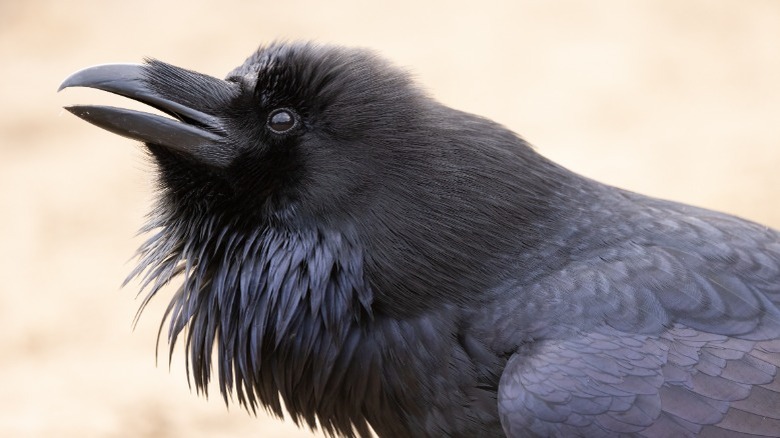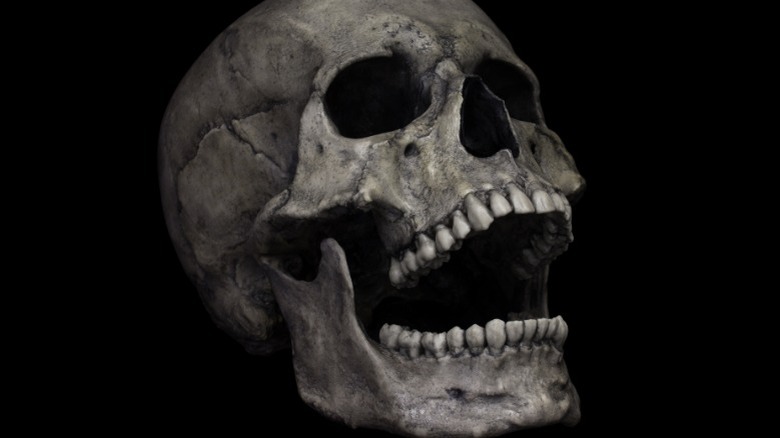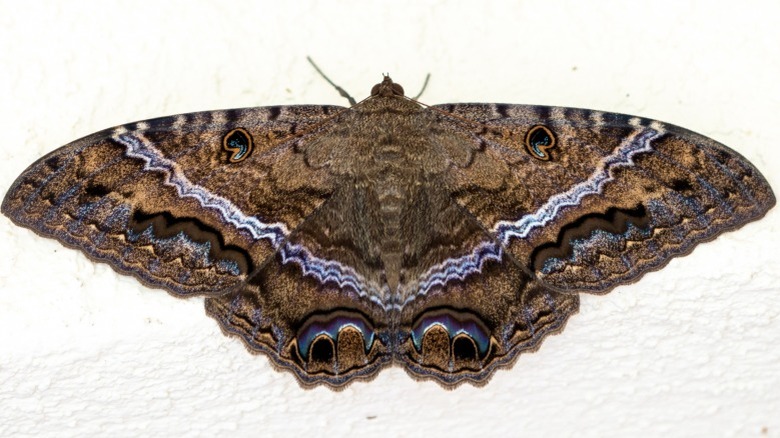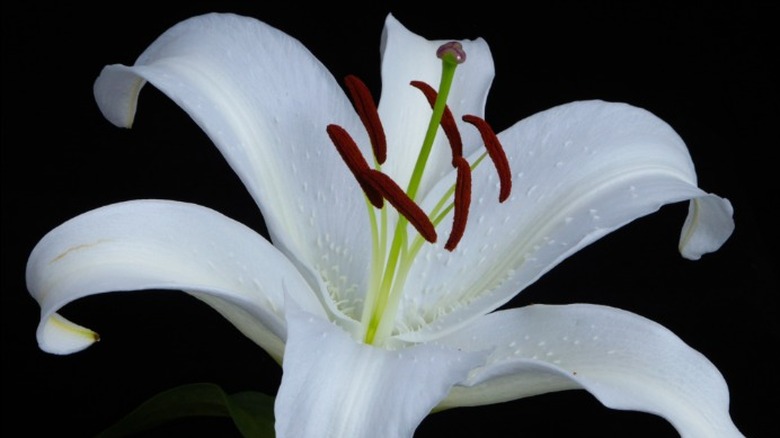Omens Of Death In Myth And Legend
Before science helped increase our understanding of nature and the universe, mankind looked to significant events in the world around them for answers. On occasion, such signs would correspond to an apparent pattern — real or coincidental — and a lasting association was forged. These seemingly prophetic omens were not taken likely, and, over time, evolved into powerful superstitions that many still believe to this day.
According to former psychology professor Stuart Vyse in an interview with The British Psychological Society, superstitions likely began as a way to cope with life's uncertainties. The human mind is inherently logical, so relating an outcome — good or bad — to a random event or object gives people a perceived sense of control over a situation. Vyse added that positive superstitions — like carrying a lucky rabbit's foot — may even provide a slight "psychological advantage." But the same cannot be said of negative superstitions.
Favoring unfounded magical thinking over scientifically proven facts can be harmful, especially in instances where medical treatments and political agendas are involved. (Think bloodletting and the Salem Witch Trials.) Still, humans can't help but fixate on their inevitable demise. Throughout history, people have identified many warning signs of imminent mortal peril, with some of these beliefs even surviving into the modern age. From misunderstood animals to unexplained natural phenomena to potentially dangerous gemstones, here are some omens of death in myth and legend.
Spectral black dogs
Throughout England, the phantom black dog has long been a symbol of foreboding and death. Called black shucks, hellhounds, or individualized names like the Barguest and Padfoot, these creatures stalk remote country roads or hang out around graveyards, churches, and sites where murders have occurred. Seeing one — or hearing one howl – is a sure sign that you or someone you know is marked for death.
While sometimes viewed as guardians, most black dogs take on ominous traits like large glowing eyes, mangy fur, and massive size. Some even emanate a powerful sulfur stench or drag chains behind them. Unlike your average stray dog, these creatures also possess supernatural qualities, like the ability to vanish into thin air, walk without leaving footprints behind, or create scorch marks on the ground. In some legends, the devil himself is said to sometimes take the form of a large black dog.
According to a 2020 article published in Cultural Analysis, such fearsome death-affiliated canines likely originated in ancient mythology. In Greek tales, a three-headed fiery-eyed dog called Cerberus guards the underworld. Norse traditions tell of an equally terrifying wolf figure named Fenrir, who will eventually break loose from his chains and devour the sun during the end times. Indeed, the ghostly dog legend is alive and well today, most notably in J.K. Rowling's 1999 novel "Harry Potter and the Prisoner of Azkaban," which features a portentous black dog called the Grim that foretells the death of anyone who sees it.
Mirror mayhem
In ancient times, people regarded their reflections in pools of water with great trepidation. Explaining what was — in the absence of science — a truly baffling phenomenon led to the belief that a person's reflected likeness was their soul separated from their body. This alone wasn't cause for concern — unless the reflection was disturbed. Anything from an aquatic animal to an evil spirit lurking in the deep could harm or even steal a person's soul while in this delicate state, and such a violation never boded well for the soul's owner.
This superstition exists in cultures all over the world and also applies to one's shadow. Naturally, it eventually extended to mirrors as well. Breaking a mirror — which damages the soul reflected within — incurs seven years of bad luck. This oddly specific timeframe derives from the ancient Roman belief that a person's body renewed itself every seven years. While that might seem like a long time, it's still a lucky break as some consider broken mirrors the ultimate bad omen.
Given their incredible power, mirrors can also cause death. Three people should never look into a mirror at the same time, as doing so guarantees that one of them will soon die. Mirrors should also be covered or turned immediately after someone has passed, lest another person see their reflection and join them in death. Worst of all, a person who looks into a mirror and finds it empty is close to death, their soul having already been ferried away.
Owls
With their unusual forward-facing eyes, hair-raising vocalizations, and nocturnal habits, it's not surprising that there are many superstitions surrounding owls. Not all are bad — the ancient Greeks, for example, viewed owls with reverence, associating them with the goddess Athena and wisdom. But in Roman culture, owls represented the ultimate portents of doom and gloom, even foretelling the deaths of Julius Caesar, Augustus, and other prominent figures through their ominous hooting.
Due to their global distribution, death-related owl mythology exists in many cultures. In English folklore, owls flying into a house, perching on a roof, appearing outside the window of a sick person, or calling nearby are all considered death omens. Many Native American tribes also associate owls with death and the afterlife. The Cherokee, Cheyenne, Ojibwa, and others view owls as either linked to or embodying the spirits of the deceased and believe that, in certain situations, seeing one in the daytime is a sign that someone will soon die. Similarly, the Apaches believe that dreams featuring owls presage death.
According to a 2020 article published in Ethnohistory, the Aztecs also believed that owls signified imminent demise, with barn owls, in particular, serving as messengers to Mictlantecuhtli, the god of death. Owls are still viewed with fear in some parts of Mexico, as evidenced by the adage "Cuando el tecolote llora, el indio muere," which translates to "When the owl cries, the Indian dies."
Doppelgängers
In European folklore, seeing your doppelgänger (which means "double-goer" in German) was a sign that you were going to die — especially if it happened three times. In Scotland, England, and Ireland, such spectral evil twins were called fetches or wraiths, and, when sighted by others or the person in question at night, it meant that death was in the cards for the replicated individual — or had already taken place.
The concept of a supernatural double likely arose from several ancient mythologies. Ancient Egyptians believed that part of an individual's soul split off into an identical physical entity known as the ka. Norse folklore features the fylgja, a protective spirit double — sometimes taking an animal form — that accompanies a person throughout their life and often appears to them right before they die.
Curiously, several historical figures reported seeing their ghostly doubles before they passed. Poet Percy Bysshe Shelley supposedly saw his doppelgänger multiple times before his death in 1822, once on his terrace and again as a silent figure that led him to the shore and pointed at the ocean just days before he died at sea. Similarly, President Abraham Lincoln saw two versions of himself in the mirror — one normal and a second noticeably paler — on three occasions in 1860, per the book "Abraham Lincoln" by Noah Brooks. His wife, Mary Todd Lincoln, took the doppelgänger as a sign that her husband was marked for death. Indeed, he was assassinated just five years later.
Opals
Shining like rainbow fire, opals are beautiful gemstones that catch the eye. But wearing one is only advisable for those born in October – all others who dare to don or even own one face bad luck or, worse, death. Crafting an engagement ring out of opals is an especially bad idea as it all but guarantees your betrothed will perish early in the marriage (though, as the legends go, adding a few diamonds to the mount can reduce this risk).
Once viewed as lucky in ancient Greek, Roman, and Arabic cultures, over the years opals became affiliated with magic, witchcraft, and the malicious, terror-inducing "Evil Eye" in medieval England, likely due to their resemblance to the eyes of ill-omened animals like cats and snakes. Already wary of the gemstone, Europeans grew genuinely fearful of opals in the mid-14th century when they were stricken with the Black Death.
Many believed that opals caused the sickness, as the fiery colors of an afflicted person's opal allegedly grew brighter when they were first infected, only to become dull with its wearer's death. This effect was likely due to the opal's natural play-of-color, a chameleon-like quality made possible by tiny spherical silica structures within the stone refracting light, dramatically changing its color and brilliance when viewed at different angles.
Black cats
Cats have long been affiliated with the occult, as they are believed to be a preferred familiar of witches. Black cats in particular are a popular subject in folklore, revered as often as they are feared. Over time, black cat superstitions have morphed and mixed together, making for a confusing mishmash of beliefs as well as lower adoption rates for those unfortunate felines sporting black fur.
In some parts of the world — including Britain and Japan – they are considered lucky, while in others — like the United States – the exact opposite is true. Still, in a few very specific instances, a black cat serves as an omen of death. An old Italian superstition holds that a black cat sitting at a sick person's bedside foretells their imminent demise, while, in other cultures, hearing a black cat meowing at midnight means certain death for someone nearby.
And when it comes to that whole business of a black cat crossing your path, there are a few important stipulations. If a black cat walks toward you, it brings prosperity. If it walks or runs away from you, crosses from left to right, or changes its mind and doubles back, it causes bad luck. And if one crosses at all during a funeral procession, start planning a second funeral because another member of the departed's family will soon die.
Strange lights
Mysterious light phenomena have plagued humanity on a global level since ancient times. Called will-o'-the-wisp, jack-o'-lanterns, ignis fatuus, chir batti, St. Elmo's fire, luz mala, corpse lights, and orbs depending on where they are encountered, supernatural lights are almost always considered harbingers of death. Will-o'-the-wisp and jack-o'-lanterns often occur as patches of glowing light above wet earth in marshes, while corpse lights occur in churchyards or near graves.
Superstition holds that such lights are spirits that appear to individuals before their deaths, sometimes malevolently attempting to lead them further into dangerous bogs while other times serving as gentle messengers from deceased relatives warning them to prepare for their own coming deaths. In Mexico, disembodied lights are thought to be the souls of witches, while in India — where they are known as chir batti – they are mostly harmless but do occasionally lead followers astray.
St. Elmo's fire – the strange brilliant light that illuminates ship masts during storms at sea — is considered a warning from the ghosts of drowned sailors in some circumstances, while, in others, it is considered a blessing sent from the patron saint of seafaring, St. "Elmo" Erasmus himself. If the light occurs singly, finds its way onto the ship's deck, is touched, or, worse, surrounds a sailor's head, it is a sign of shipwreck and death. Most ghostly lights are likely attributed to the spontaneous combustion of gases released during decomposition, bioluminescent organisms, or the luminous discharge of atmospheric electricity during storms.
Crows and ravens
With their black feathers, harsh calls, habit of scavenging, and intelligent and bold personalities, crows and ravens have long been associated with death. Like cats, they are thought to be common witch familiars, and the devil is said to often disguise himself as a raven. Ravens are sacred in Norse mythology, with two of the birds – Hugin and Munin – personally attending the god Odin. Ravens, therefore, became a common emblem for Vikings, and, because of this, the bird gained a negative reputation among conquered peoples.
In English folklore, ravens are viewed as messengers of death, signifying coming disasters like storms and floods, war, and disease. It was also widely believed that ravens could foretell death, possibly due to their keen sense of smell, their penchant for eating carrion, and the fact that their croaking call resembles the ominous words "corpse, corpse." A raven calling on one's left in the morning is terrible luck, seeing two or more together is a bad omen, and seeing or hearing one near a sick person is a sure sign that they will die.
As smaller and more numerous cousins of the raven, crows share many of their superstitions but also have a few of their own. Crows tapping on a window, fluttering around a person's head, making an appearance in a churchyard, cawing three times near a home, thrice flying over the same house, or, worse yet, landing on a house is a sure sign that death is imminent.
Dreams involving matrimony or teeth
Sometimes, the subconscious mind supplies its own supposed death omens — and they are not always intuitive. In many cultures, it is widely believed that dreams deal in opposites. This means that dreaming of something obviously negative — like one's own death or the death of a family member — is actually a good thing, while dreaming of a seemingly joyous event such as a wedding signifies a more ominous gathering, like a coming funeral.
More sinisterly, an old Islamic interpretation holds that dreaming of losing all of your teeth indicates that death is coming for you or a relative. Other cultures share a similar belief about teeth dreams, extending the death omen to include close friends. The association of tooth loss with death likely relates to the ancient belief that all body parts (including one's teeth) must be interred together to ensure a healthy — and complete — afterlife.
Those unlucky souls buried without all of their bits and pieces are doomed to wander the afterlife without them for eternity or, more awkwardly, forced to spend Judgement Day searching for every lost tooth. The connotation could also relate to the European fear of sorcery, as errant body parts could easily fall into the wrong hands, making it possible for a witch to bring harm or even death upon their still-living owner.
Mysterious knocking
It seems that the Grim Reaper has good manners. According to both Scottish and German legends, three poignant, evenly-spaced knocks heard at the door, window, or even on the headboard of the bed in the absence of anyone doing the knocking are a sure sign that death will soon make a call to someone in the household. Such supernatural knocks are thought to be created by the entity of Death himself.
What's more, smaller tapping and knocking sounds heard within the walls of a house also signify coming death. Such sounds are common in old houses as they experience temperature changes and settle, but may also be produced by the aptly named deathwatch beetle (pictured). These small beetles feed on wood as larvae and, as adults, ram their heads against their tunnel walls to attract mates. They are most often heard at night — precisely when one may be up sitting concerned at the bedside of a sick relative.
Black butterflies and moths
Butterflies are most often associated with springtime and joy in the modern age. But, traditionally, many believed that they were the physical representation of a person's soul. In some cases — as in Burmese culture — the individual's soul merely flits around while its owner sleeps. Care should be taken during rousing, though, for if the soul butterfly is not given enough time to return, death is guaranteed.
In other cultures, human souls only took butterfly form after death. In ancient Egypt, the soul departing its vessel at life's end was compared to a butterfly emerging from its chrysalis. Irish and Scottish folklore holds that butterflies are the souls of the recently departed on their way to the afterlife, though others believe that they are wandering souls — such as those of unbaptized children — who never made it to the next stage after death.
Still, seeing a butterfly is typically a positive experience (and might even be a visit from a deceased relative) but encountering one at night is a sure sign of coming death. Naturally, this superstition mostly applies to those nocturnal butterflies called moths. In Mexican and Caribbean cultures, black butterflies are especially feared. If one enters a house while someone is sick or, worse, flies to all four corners, the afflicted individual will soon die. Such superstitions still hold true in regards to two sinisterly named moths: the black witch (pictured) and the death's-head hawk-moth – both of which just so happen to emerge in October.
Falling portraits
Similar to the belief that reflections house souls, people once thought that images of a person's likeness — such as portraits and photographs — contained a part of their subject's spirit and were therefore supernaturally connected to their sources of inspiration. As such, any ill that befell a person's depiction was considered a warning sign for its living counterpart. In the most extreme case, if a hung portrait fell off the wall for seemingly no reason, this meant that the pictured individual's death was forthcoming.
Several variations of this superstition exist. First, the death omen is invalidated if there is an obvious cause for the fall, such as a broken hanger or an earthquake. In some versions, the picture's glass acts as a protective barrier and must break in order for the fall to be considered a death omen — but this is up for debate. Still others hold that death is transferable to a housemate. In the most lethal interpretation, the framed subject is at risk no matter where they are when their portrait falls. And the most superstitious even consider any falling picture, landscape or otherwise, as a death omen for anyone around when it happens.
Fragrant flowers
While flowers are often associated with beauty, love, and hope, one cannot deny their significant affiliation with graves and death. And among the superstitious, not all flowers were created equal. Oddly enough, fragrant flowers – as well as those that are white, naturally drooping, or growing out-of-season — are powerful death omens. This is likely due to the use of strong-scented flowers to mask the odors of decay during funeral proceedings. Aromatic flowers have been associated with departed souls since pagan times, and, as such, smelling ghostly flowers when none are around is a bad sign for the living.
Likewise, bringing such pungent blooms into the home invites disaster. The intensely fragrant flower of the broad bean, believed to hold the souls of the dead in its heady perfume, was greatly feared in ancient times, and inhaling its scent was said to induce bad luck, terrible visions, and even madness. Similarly, sweet-smelling white lilies – while also symbols of purity — are strongly associated with funerals and become instant death omens indoors. Snowdrops, with their nodding heads and shrouded white flowers, are also considered terribly unlucky — so much so that a single snowdrop flower is known as a "death token," and, when brought inside, marks someone in the household for death.
Celestial events
In cultures the world over, celestial events such as solar and lunar eclipses, comet passes, and auroras were considered portents of death on a massive scale. Eclipses were historically viewed as a giant supernatural or demonic entity stealing the Earth's life-giving light and were said to foretell the death of prominent figures like kings, serve as a harbinger of war, and even as a warning of the deadly Black Death. To stave off catastrophe, people would bang objects together, fire guns, and shout in an attempt to scare the eclipsing agent away.
Similarly, comets and auroras – viewed as giant fires in the sky — have long been considered signs of coming war, death, and general disaster. Throughout history — even as recently as 1997 when members of the Heaven's Gate doomsday cult died by mass suicide due to the comet Hale-Bopp — comets have been regarded as a signal of the second coming of Christ and end times.
Admittedly, such major celestial events would indeed be terrifying in the absence of any explanation. But science has since revealed that eclipses are really just giant shadows, auroras are caused by atmospheric charged particles, and comets are nothing more than orbiting balls of ice, gas, and dust. Still, superstitious individuals can't help but view these dramatic natural displays as the ultimate death omens.
